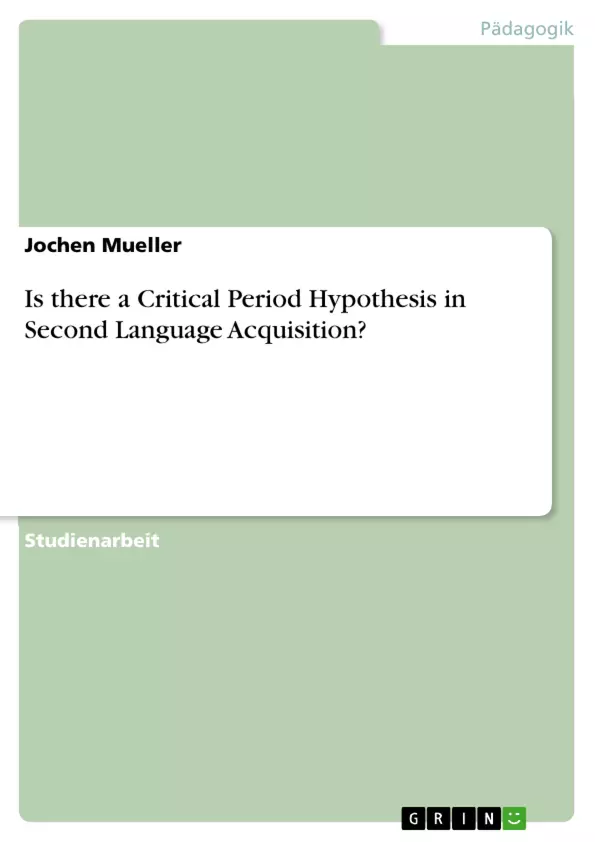This paper wants to research into the question of the existence of a Critical Period Hypothesis (CPH) in Second Language Acquisition (SLA). Further, since this theory was already introduced in the early 60’s, I will have a closer look at the modifications of the CPH, i.e. the Sensitive Period Hypothesis (SPH). By the help of taking some of the findings from different studies into account, I will try to answer the underlying question.
Inhaltsverzeichnis
- Introduction
- The Critical Period Hypothesis
- The Sensitive Period
- Implications of the CPH in SLA
- L2 acquisition- the nature of the problem
- The Fundamental Difference Hypothesis and the Role of UG
- CPH Termini
- Conclusion
- Bibliography
Zielsetzung und Themenschwerpunkte
Diese Arbeit befasst sich mit der Frage, ob es eine kritische Periode für den Erwerb einer zweiten Sprache (L2) gibt, wie es die Critical Period Hypothesis (CPH) postuliert. Die Arbeit untersucht die CPH und ihre Modifikationen, insbesondere die Sensitive Period Hypothesis (SPH), und analysiert die Ergebnisse verschiedener Studien, um die Gültigkeit dieser Theorien im Kontext des L2-Erwerbs zu beleuchten.
- Die Existenz einer kritischen Periode für den L2-Erwerb
- Die Rolle des Universal Grammar (UG) im L2-Erwerb
- Der Einfluss des Alters auf die L2-Kompetenz
- Die Unterschiede zwischen dem Erwerb der ersten (L1) und der zweiten Sprache (L2)
- Die verschiedenen sensiblen Phasen im L2-Erwerb
Zusammenfassung der Kapitel
- Introduction
Die Arbeit beginnt mit einer Einführung in das Thema der kritischen Periode für den L2-Erwerb und stellt die Problematik anhand von Beispielen aus der Praxis dar. Sie führt den Leser in die CPH und ihre Bedeutung für das Verständnis des L2-Erwerbs ein.
- The Critical Period Hypothesis
Dieses Kapitel definiert die CPH und beleuchtet ihre historischen Wurzeln. Es erklärt die ursprünglichen Annahmen von Lenneberg und die spätere Weiterentwicklung der Theorie. Es wird auch die Sensitive Period Hypothesis (SPH) als Modifikation der CPH vorgestellt.
- Implications of the CPH in SLA
Dieses Kapitel untersucht die Auswirkungen der CPH auf den L2-Erwerb. Es analysiert verschiedene Studien, die den Einfluss des Alters auf die L2-Kompetenz untersuchen, und diskutiert die unterschiedlichen Ergebnisse. Es wird auch die Rolle des Universal Grammar (UG) im L2-Erwerb beleuchtet und die Fundamental Difference Hypothesis (FDH) vorgestellt.
- CPH Termini
Dieses Kapitel befasst sich mit den spezifischen sensiblen Phasen im L2-Erwerb, die von verschiedenen Forschern vorgeschlagen wurden. Es analysiert die unterschiedlichen Ansätze und die empirischen Befunde, die diese Theorien stützen.
Schlüsselwörter
Die Schlüsselwörter und Schwerpunktthemen des Textes umfassen die Critical Period Hypothesis (CPH), die Sensitive Period Hypothesis (SPH), den Erwerb der zweiten Sprache (L2), den Einfluss des Alters auf die L2-Kompetenz, das Universal Grammar (UG), die Fundamental Difference Hypothesis (FDH), die sensiblen Phasen im L2-Erwerb und die verschiedenen Studien, die diese Theorien beleuchten.
- Quote paper
- Jochen Mueller (Author), 2013, Is there a Critical Period Hypothesis in Second Language Acquisition?, Munich, GRIN Verlag, https://www.grin.com/document/273094



